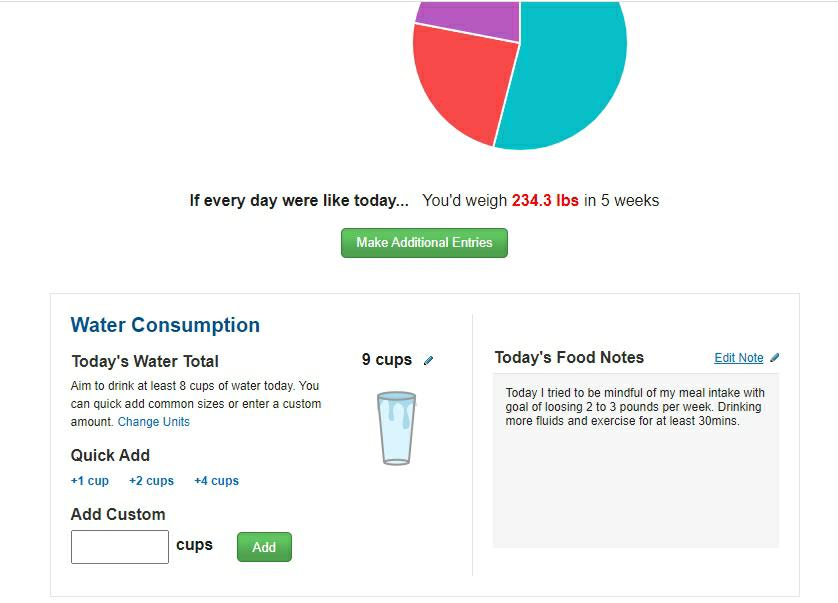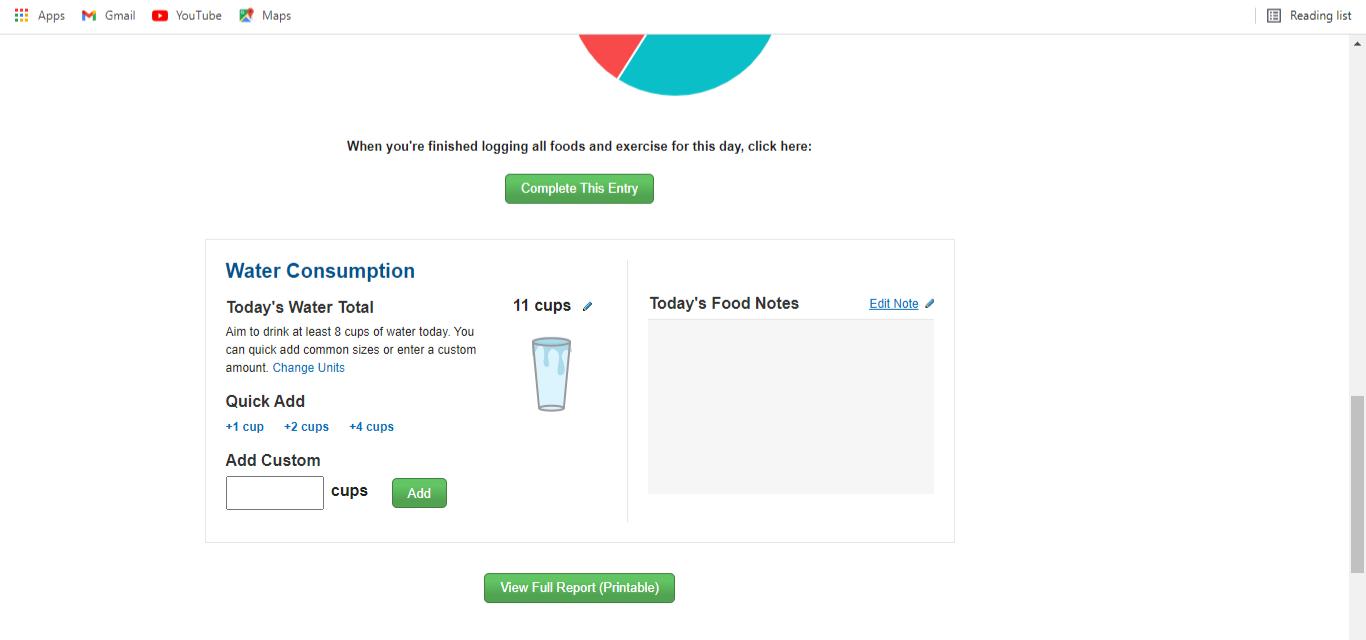Introduction
The Body Mass Index (BMI) is calculated by dividing a person’s weight (kgs) by their height (m2). My weight is 230 pounds (104kgs) and height is 5’5 feet (1.65 meters), therefore;
BMI = 104/2.725 = 37.82
The result indicates that my BMI is way above the recommended range for a healthy person. Based on the Hamwi scale, the normal BMI is considered to lie within a range of 18.5-24.9 (Beals, 2019). For a person’s BMI to fall within the recommended range, it is mandatory to adopt healthy eating to avoid accumulating excess weight or being underweight. Weight can be contained, as opposed to height cannot be varied because it is a factor of a person’s creation. I need to adjust my eating habits with the aim of reducing my weight.
Food Diary



Charts



Analysis
Despite my BMI being above the recommended range, my Recommended Dietary Allowances (RDA) indicates that I do not meet the required nutrient through the everyday meals. Below are some of the nutritional measures I desire to follow in meeting the RDA:
Carbohydrates
The RDA for carbohydrates is 230g, but I was not able to attain this for day 1 and day 3. The daily intake for day 2 was 268, and is the only day I attained the RDA. Valdes et al. (2018) recommend intake of rice, corn, and pure glucose to improve the carbohydrate intake. The foods contain a healthy amount of kilocalories required to enable me meet the RDA. The foods also provide the right energy needs, which is crucial and effective in sustaining healthy nutrition. It would also be appropriate to reduce intake of snacks that may well contribute to poor dietary intake.
Fat
The RDA for fat based on my goal is 61, and I was not able to meet this target for any of the three days. My fats intake for day 1, 2, and 3 was 43, 53, and 41, respectively. The shortfall further complicates my nutritional intake requirements that necessitate an immediate change in the eating schedule and dietary requirements. According to Valdes et al. (2018), legumes and peanut butter are good sources of fat that I should integrate into the meals to augment the fats intake. However, to watch on excess weight, I need to reduce the intake of saturated fats and cheese.
Protein
My RDA for protein is 92g, which is high compared to the actual protein intake for day 1 and day 3 which was 16 and 39, respectively. The attained protein intake for day 2 was 108 and is the only day I was able to meet my RDA. The data reveals that I need to substantially improve my protein intake. The best foods to integrate into my meals include chicken meat, beef, and fish. I also need to balance the intake for the outcome to be consistent and avoid the huge variation.
Cholesterol
My cholesterol intake for the three days was 171, 154, and 155, respectively. The cholesterol intake can be enhanced by consuming eggs and fired meat. However, given the high weight I will reduce the consumption of these foods.
Fiber
My fiber intake for the three days was 19, 37, and 16, respectively. The fiber intake can be enhanced by consuming avocado, beans, and fresh fruits.
Sugar
The RDA of sugar is 69g, which is the only nutrient that had no great variation. My sugar intake for the three days was 80, 66, and 70, respectively. The major goal in this scenario is to reduce the intake of foods containing high levels of sugar, especially juices that usually have high sugar content, and ensure consistency.
Sodium
The RDA for sodium is 2300mg and my intakee was slightly low at 1916 and 1713 for days 1 and 2. For day 3 my sodium consumption was above the RDA at 2900. To increase sodium intake, I need to consume more fish and salty foods. Sodium is a vital nutrient needed to strengthen the body’s immune system.
Diet Plan
To meet the RDA, I commit to making the following changes to my meals in the next three months. First, I undertake to increase my carbohydrates intake to meet my RDA of 250mg. Second, I will increase the intake of fats to the RDA of 78mg. Lastly, I plan to increase my sugar intake to meet my RDA of 88g.
The plan will help to improve my diet since it contains valuable nutrients in lowering the challenges correlated to poor diet. I will have to be consistent with the diet plan and ensure the specific food to meet the nutritional intake is available.
However, the diet plan may be constrained by diet imbalances, financial constraints, and obtaining the food items that will provide the required nutritional value. I will also be intentional in organizing my meals by planning the appropriate time to eat or drink (Beals, 2019). The plan can be made easy by using a qualitative strategy in ensuring that everything is followed in detail for a successful outcome.
Goals
The following are the goals that will enable me to meet the diet plan. One, by March 12th, I will have attained 250g of carbohydrates intake per day. Two, in four weeks’, time, I should have reduced my weight by 20lbs weight by balancing the intake of fats to reach my RDA of 61mg. Finally, by March 15th, I will have increased the sugar intake to my RDA of 69mg.
Conclusion
The class has helped to improve my understanding of ideal and effective nutritional requirements. The required nutritional intakes and calorie amount is a key solution in ensuring I eat a healthy diet that meets the required standards. Overall, I need to ensure my meal has an adequate balance of all macro- and micro-nutrients. I will incorporate the nutritional skills acquired in advising people on the best meals to take and comprehensive strategies aimed at meeting their RDA.
References
Beals, K. A. (2019). Potatoes, nutrition and health. American Journal of Potato Research, 96(2), 102-110. Web.
Valdes, A. M., Walter, J., Segal, E., & Spector, T. D. (2018). Role of the gut microbiota in nutrition and health. BMJ, 361. Web.